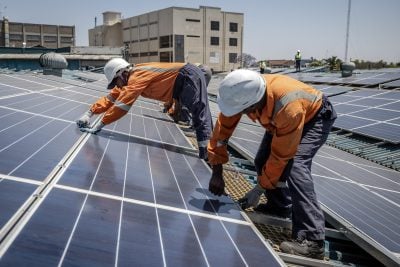The African Development Bank recently published the 2022 Africa Industrialisation Index, confirming that Africa’s most industrialised economies are South Africa, Morocco, Egypt, Tunisia and Mauritius.
Less well known is what the countries that improved the most over the past 10 years have in common – and what it tells us about these countries’ efforts to move away from economic dependence on extractives toward value-adding sectors.
The countries that showed the greatest progress over the past decade are Senegal, Ethiopia, Benin, Tanzania and Uganda.
Senegal now ranks an impressive 7th in the continent, up from 14th in 2011, while Ethiopia moved up to the top half of the standings, from 31st to 25th. Benin jumped a whopping 14 places to 18th, while Uganda rose 5 to 20th and Tanzania rose 6 to 21st.
Historically, all these countries’ economies relied on the export of raw commodities with minimal, if any, local processing. These were predominantly gold, phosphate and oil in Senegal; coffee in Ethiopia; gold and coffee in Uganda; cotton in Benin; and gold, metal ores and coffee in Tanzania. These sectors provided foreign exchange, some tax revenues and some employment, but did not allow these countries to achieve rapid, widespread, and sustained gains in productivity and welfare.
More recently, a common thread that has emerged across these rising African economies is entrepreneurial innovation and an increasingly deliberate strategy by the government to facilitate private investment into value-adding industries.
These industries enable larger-scale job creation, provide avenues to develop new product lines, and generate spill-overs across different types of firms and to other parts of the local economy. The promotion of value-adding sectors by government can play an important role in the industrialisation process.
Industries bloom
For example, through its Plan Emergence Senegal, the Senegalese government is promoting greater value addition in the economy. Its flagship Diamniadio Industrial Park opened in 2018 and has attracted investors that assemble vehicles, process food and produce garments, pipes and packaging.
It also hosts a vaccine manufacturer and a data centre. Agro-industrial performance in the park and beyond is particularly notable. According to the International Trade Centre’s Trade Map, exports of frozen fish quadrupled between 2010 and 2021 and now account for 5 per cent of Senegal’s exports, the fourth largest after oil, phosphate and gold. Exports of groundnuts, which now rank fifth, have also surged from a mere $3 million in 2010 to $280 million. They also account for 5 per cent of Senegal’s exports. Similar ‘take-offs’ are being seen in the export of soups and broths, cashew nuts, beauty products and fertilisers.
Ethiopia has also actively pursued industrialisation over the past decade, spearheaded by the Prime Minister’s Office and a handful of other key government agencies. Despite the dampening effect of the pandemic and the conflict in the Tigray region in recent years, progress remains palpable.
Ethiopia’s most obvious success story has been in the airline industry, with Ethiopian Airlines becoming Africa’s leading airline. It generates $3bn in exports for the country, between its passenger and cargo businesses, accounting for 35 per cent of Ethiopia’s exports. The government played a lead role in this sector, by engaging in rapid learning through a partnership with an American airline, TWA.
Another sector that started taking off in the early 2000s and has grown further in the last decade is floriculture. Exports of cut flowers rose from $0 in 1999 to $139 million in 2010 – by which time there were 81 flower farms and 50,000 workers. By 2021, exports had reached $254 million, accounting for 3 per cent of Ethiopia’s total exports. Ethiopia is now the world’s fifth largest flower exporter.
Ethiopia has also seen progress in agriculture value chains such as legumes, potatoes, goat meat and soybean. Beyond agriculture, the apparel, automotives, pharmaceuticals and electric machinery industries kicked off Ethiopia’s industrial park strategy.
Exports of apparel surged from just $35 million in 2010 (just 0.7% of exports) to $143 million in 2021, comprising 2 per cent of exports.
Finally, Uganda, Benin and Tanzania have all achieved notable progress following an agro-industrial path. In Uganda, various processed products and commodities have seen growth, including in cocoa, palm oil, dairy, wheat, beans, fish and steel. This is on top of the country’s success in pharmaceuticals, where exports rose from just $1 million in 2010 to $37 million last year, accounting for 1 per cent of Ugandan exports.
Uganda’s progress on a wide range of products bodes well for its industrialisation, despite being land locked.
Meanwhile, Benin has made initial progress in cotton value addition. Exports of cotton oil cake, rose from just $4 million to $32 million, cotton seed oil exports more than doubled from $6 million to $13 million, and woven cotton fabrics exports rose from $5 million to $11 million.
In Tanzania, exports of the country’s prized kilombero rice surged from just $14 million in 2010 to $302 million in 2021 off the back of major public-private initiatives such as the Southern Agricultural Growth Corridor of Tanzania (SAGCOT). As a result, rice is now Tanzania’s second largest goods export, after gold.
Beyond agriculture, major progress is being made in processed goods, such as beauty and cosmetic products, that have seen exports surge from just $4 million in 2010 to $66 million last year.
A common message across these countries – as well as other countries that registered an improvement in their Index ranking, such as Ghana, Mozambique, and Rwanda – is that focus and facilitation around specific industries that have the potential to attract investment, create jobs and boost exports, is essential.
Problem-solving around sectoral binding constraints is, after all, what the countries that top the ranking did years ago. South Africa, Morocco, Tunisia, Egypt and Mauritius all have had successful episodes of proactive, market-oriented industrial policy, which was key to the progress they have made in GDP per capita, living standards, and human development.
It is good news that many African countries are learning from these experiences and working to adopt a similar approach. If their recent progress at industrialising their economies can be sustained over time, and other countries can follow suit, the overall industrialisation of the continent becomes that much more likely.
Want to continue reading? Subscribe today.
You've read all your free articles for this month! Subscribe now to enjoy full access to our content.
Digital Monthly
£8.00 / month
Receive full unlimited access to our articles, opinions, podcasts and more.
Digital Yearly
£70.00 / year
Our best value offer - save £26 and gain access to all of our digital content for an entire year!
 Sign in with Google
Sign in with Google 


